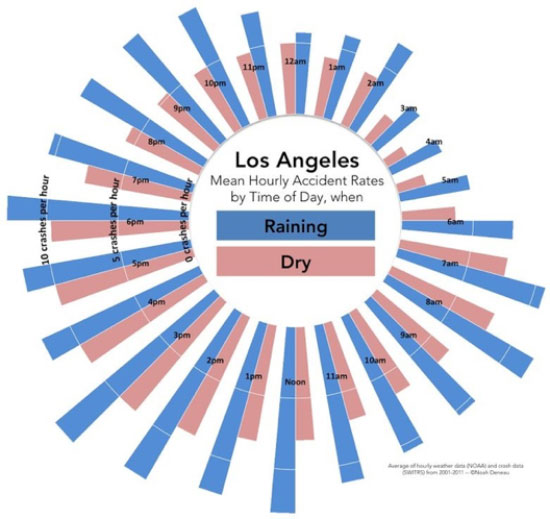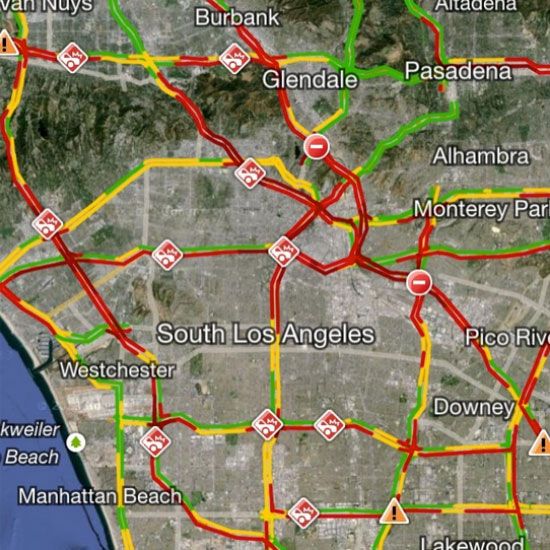Los Angeles is famous for freaking out when it rains. Recently, Noah Deneau, an electrical engineer from Austin, Texas, graphically illustrated the effect of rain on the rate of traffic crashes in Los Angeles. The results provide a telling snapshot of the perils of driving (and walking and biking) when it’s raining in LA.
Deneau processed 11 years of weather reports from NOAA and accident data from SWITRS to create a telling chart that demonstrates the elevated dangers of driving in the rain in Los Angeles. The red bars show the mean crash rate per hour for dry weather; blue bars show wet weather:

On a typical dry day, an average of 5-10 crashes per hour occur in Los Angeles, with the most dangerous time of day between 3 p.m. and 5 p.m. However, on a rainy day, many more crashes occur depending on time of day – peaking close to 15 per hour around 3 p.m.
A combination of factors contributes to higher crash rates when it rains. Road surfaces are slicker due to buildup of water, oil, and grease, which reduces the traction of tires and can lead to skidding and hydroplaning. Visibility can also be poor, particularly for roadway hazards (such as flooding, mudslides, fallen tree branches) and for people walking and biking who may not be well-lit.
Yet, drivers in all regions with rain face these conditions, so what makes Los Angeles particularly bad? Los Angeles drivers are often stereotyped as being more aggressive and prone to speeding and tailgating, but it’s difficult to generalize the driving habits for millions of people. Angelenos are less accustomed to driving in rainy conditions, so inexperience plays a major factor – it’s certainly important to slow down and use care when driving in the rain.
Perhaps the biggest contributor, however, is the built environment: as the densest region in the country, Los Angeles has more people driving, walking, and biking (and more hazards) in a highly concentrated area than any other region. This density, coupled with dangerously high speed limits on many streets, produces a transportation network that is highly susceptible to conflicts and crashes when the weather is good – and subject to failure when the weather is bad. Mistakes and poor judgment are common for drivers everywhere, but in Los Angeles, there is much less margin for error.
The good news is that City of Los Angeles Department of Transportation (LADOT, led by Seleta Reynolds) has put forward a bold vision to eliminate traffic deaths by 2025 and make its streets safer for all users. Meanwhile, Metro, the region’s transit agency, is aggressively expanding transit to provide more transportation choices. While LADOT and Metro might not be able to change its residents driving habits or experience in poor weather conditions, they’re leading the charge to reduce risk of crashes in both good and bad weather.


